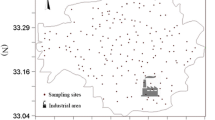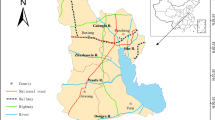Abstract
Surface soil samples collected from Nansi Lake catchment were analyzed for mercury (Hg) to determine its spatial trends and environmental impacts. Results showed that the average soil Hg contents were 0.043 mg kg−1. A positive correlation was shown between TOC and soil Hg contents. The main type of soil with higher TOC contents and lower pH values showed higher soil Hg contents. Soil TOC contents and CV values were both higher in the eastern catchment. The eastern part of the catchment, where the industry is developed, had relatively high soil Hg contents and a banding distribution of high Hg contents was corresponded with the southwest-northeast economic belt. Urban soils had higher Hg contents than rural soils. The urbanization pattern that soil Hg contents presented a decreasing trend from city center to suburb was shown clearly especially in the three cities. Soil Hg contents in Jining City showed a good consistency with the urban land expansion. The spatial trends of soil Hg contents in the catchment indicated that the type and the intensity of human activities have a strong influence on the distribution of Hg in soils. Calculated risk indices showed that the western part of the catchment presented moderately polluted condition and the eastern part of the catchment showed moderate to strong pollution level. The area with high ecological risk appeared mainly along the economic belt.






Similar content being viewed by others
References
Asubiojo OI, Aina PO, Oluwole AF, Arshed W, Akanle OA, Spyrou NM (1991) Effects of cement production on the elemental composition of soils in the neighborhood of two cement factories. Water Air Soil Pollut 57-58:819–828
Chakraborty P, Babu PR (2015) Environmental controls on the speciation and distribution of mercury in surface sediments of a tropical estuary, India. Mar Pollut Bull 95(1):350–357
Chakraborty P, Sarkar A, Vudamala K, Naik R, Nath BN (2015) Organic matter—a key factor in controlling mercury distribution in estuarine sediment. Mar Chem 173:302–309
Fang F, Wang Q, Li J (2004) Urban environmental mercury in Changchun, a metropolitan city in northeastern China: source, cycle, and fate. Sci Total Environ 330(1–3):159–170
Feng XB, Qiu GL (2008) Mercury pollution in Guizhou, southwestern China—an overview. Sci Total Environ 400(1–3):227–237
Feng XB, Dai QQ, Qiu GL, Li GH, He L, Wang DY (2006) Gold mining related mercury contamination in Tongguan, Shaanxi Province, PR China. Appl Geochem 21:1955–1968
Forstner U, Ahlf W, Calmano W (1993) Sediment quality objectives and criteria development in Germany. Water Sci Technol 28(8):307–316
Hakanson L (1980) An ecological risk index for aquatic pollution control. A sedimentological approach. Water Res 14(8):975–1001
Han YM, Du PX, Cao JJ, Posmentier ES (2006) Multivariate analysis of heavy metal contamination in urban dusts of Xi’an, Central China. Sci Total Environ 355(1–3):176–186
Hilton J, Davison W, Ochsenbein U (1985) A mathematical model for analysis of sediment core data: implications for enrichment factor calculations and trace-metal transport mechanisms. Chem Geol 48:281–291
Hlawiczka S, Kubica K, Zielonka U (2003) Partitioning factor of mercury during coal combustion in low capacity domestic heating units. Sci Total Environ 312(1–3):261–265
Hu Y, Cheng H (2016) Control of mercury emissions from stationary coal combustion sources in China: current status and recommendations. Environ Pollut 218:1209–1221
Kong LH, Yang LY, Wang LF, Wang YQ, Zhu JR (2013) Distribution of heavy metals species and risk analysis in the surface sediment of Sihe River. Nonferrous Metals Eng 3(5):45–49
Li JC, Yin RZ, Luo YP, Lu YL, Zhang LD (2010) Assessment of heavymetal contamination of soils in Daxin manganese mine, Guangxi. Environ Sci Technol 33:183–186
Liang J, Feng CT, Zeng GM, Gao X, Zhong MZ, Li XD, Li X, He XY, Fang YL (2017) Spatial distribution and source identification of heavy metals in surface soils in a typical coal mine city, Lianyuan, China. Environ Pollut 225:681–690
Liu EF, Shen j, Zhang EL, Wu YH, Yang LY (2010) A geochemical record of recent anthropogenic nutrient loading and enhanced productivity in Lake Nansihu, China. J Paleolimnol 44:15–24
Müller G (1981) Die Schwermetallbelstung der sedimente des Neckars und seiner Neben. usse: eine Bestandsaufnahme. Chemiker-Zeitung 105:157–164
NAS (1978) An assessment of mercury in the environment. National Academy of Sciences, Washington, DC
Streets DG, Hao JM, Wu Y, Jiang JK, Chan M, Tian HZ, Feng XB (2005) Anthropogenic mercury emissions in China. Atmos Environ 39:7789–7806
Sun BB, Zhou GH, Liu ZY, Pang XG, Dai JR (2008) Origin of heavy metal anomalies in soils along the Shandong reach of the lower Yellow River, China. Geol Bull China 27(2):265–270
Wang LF, Yang LY, Kong LH, Li S, Zhu JR, Wang YQ (2014) Spatial distribution, source identification and pollution assessment of metal content in the surface sediments of Nansi Lake, China. J Geochem Explor 140:87–95
Wei FS, Yang GZ, Jiang DZ, Liu ZH, Sun BM (1991) Basic statistics of soil elements in China and their characteristics. Environ Monit China 7(1):1–6
Xu ZQ, Ni SJ, Tuo XG, Zhang CJ (2008) Calculation of heavy metals' toxicity coefficient in the evaluation of potential ecological risk index. Environ Sci Technol 2:029
Yang LY, Shen J, Zhang ZL, Zhu YX, Sun QY (2003) A 40-year element geochemical record and its environment implication in Lake Nansihu, Shandong Province. Geochemical 32(5):453–460
Yin YJ, Allen HE, Li YM, Huang CP, Sanders PF (1996) Adsorption of mercury (II) by soil: effects of pH, chloride, and organic matter. J Environ Qua 25(4):837–844
Zhao H, Li X (2013) Risk assessment of metals in road-deposited sediment along an urban–rural gradient. Environ Pollut 174:297–304
Funding
This research was financially supported by the Natural Science Foundation of Shandong Province (ZR2016DM10), the National Natural Science Foundation of China (41472216), and the major water conservancy scientific research and technology promotion project in Shandong Province (SDSLKY201406).
Author information
Authors and Affiliations
Corresponding author
Additional information
Responsible editor: Philippe Garrigues
Rights and permissions
About this article
Cite this article
Ren, MY., Yang, LY., Wang, LF. et al. Spatial trends and pollution assessment for mercury in the surface soils of the Nansi Lake catchment, China. Environ Sci Pollut Res 25, 2417–2424 (2018). https://doi.org/10.1007/s11356-017-0554-5
Received:
Accepted:
Published:
Issue Date:
DOI: https://doi.org/10.1007/s11356-017-0554-5




